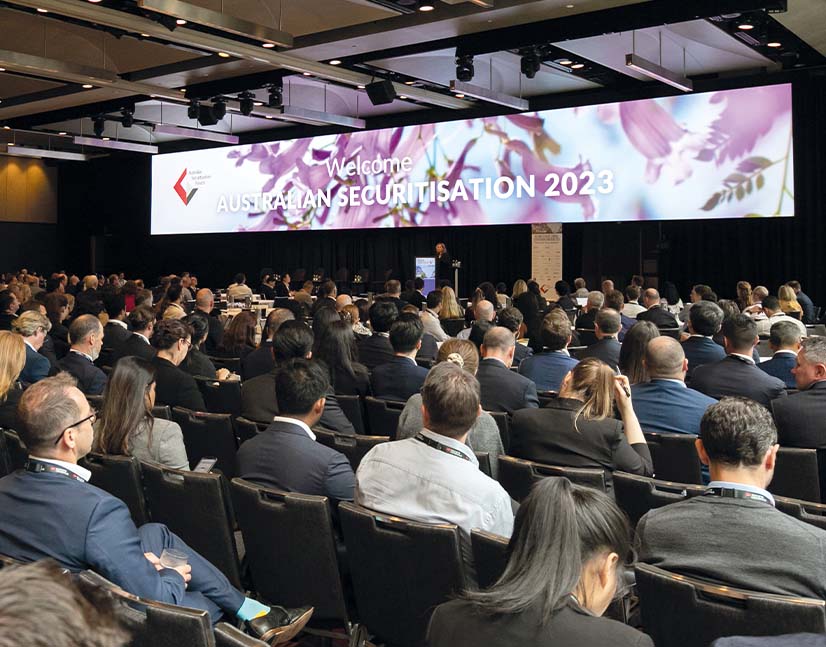
Consistent funding approach still serves mutual banks despite changeable market
The centrepiece of the KangaNews Mutual Sector Wholesale Funding Seminar is the discussion of funding conditions for the sector and the credit market more generally. In a year that has seen a clutch of significant bank failures offshore – but also notable growth in the capacity available to financial institution issuers in the Australian dollar term debt market – speakers at the 30 August seminar counselled mutual banks to stick to the old values of investor engagement, open communication and access to funding diversity.
CAPITAL MARKET CONDITIONS
Davison August has been an interesting month in capital markets. July was extremely quiet for new issuance but August delivered a bonanza of new issuance across sectors, particularly banks. Why has it been so positive for capital markets issuance especially given the economic headwinds? For how long can it carry on?
BOURKE The way I think about the Australian dollar credit market is that it seems to follow offshore markets, with a bit of a lag. June and July were very strong in the US credit market, which obviously led investors to see relative value here.
Meanwhile, conversations with arrangers have materially improved because investors have cash building up and can see some value. This makes for good issuance conditions including execution certainty.
FLANAGAN Although debt markets might have been quiet for a couple of months, the short end was on fire throughout this period. Issuers were chasing money left, right and centre – and it was hard to pin down.
Issuers have come back to the term market at a time when liquidity conditions have started to shift. There is more liquidity out there so it is prime time to come in and take some of it out of the market.
Davison There are a lot of upcoming term funding facility (TFF) maturities for the bank sector, as well as more uncertainty about how the second TFF wave will be refinanced. Are issuers tempted to strike while the iron is hot, even if it means a bit of carry on pre-funding?
PETROVSKI I think issuers need to be as nimble as possible to take advantage of conducive issuance conditions. But we also need to be cognisant of striking the right pricing balance to keep investors engaged.
From the TFF perspective, maturities have been pretty well covered from April through to date. For me, the biggest uncertainties are the sector’s funding need around the end of September and then the second big TFF tranche, in June next year. I would be taking advantage of current issuance conditions as the market seems conducive – it appears that fixed income is back in vogue.
“There is a wide range of options available but funding stability is the key. If a bank enters a market, it needs to make sure i tcan access it when it needs to. Diversity for the sake of diversity isn’t necessarily a good thing, especially as much of mutual bank funding is supplied by the robust, stable retail base.”
Davison Are positive demand conditions universal or are market users seeing differences between asset classes?
BOURKE I think it is liquidity driven. When there is rally in the US, as there has been for last few months, the most liquid assets rally first. Short-dated, senior bank paper is a close cash substitute for some investors, and over time this extends out to three- and five-year notes. If conditions remain conducive, the next most liquid assets rally next and so on.
There are still some mixed deal outcomes in our market. One UK bank tier-two transaction went pretty well, with a big book and a solid rally after pricing. We also saw a Japanese bank that priced on top of the curve and didn’t rally as much. Outcomes depend on pricing.
As for structured finance, mortgage and other asset-backed securities are very popular right now because the asset class takes time to reprice so investors see relative value compared with US spreads, for example.
Davison Australian dollar bank deal sizes have grown more or less across the board, from major-bank senior unsecured to some of the residential mortgage-backed securities deals that have priced in recent weeks. Is this just making up for the really quiet issuance years during the pandemic or is it reflective of wider system growth?
BOURKE I’m not sure it is either. From a fund management perspective, I think a lot of investors reassessed their liquidity policies during COVID-19. As a result, many of our peers now hold significantly more liquid assets than they used to.
Investors like liquid assets, which includes financial institution securities, because they can change their mind if there is a big sell-off and credit locks up. The financial sector gives more flexibility. Some of the assets you mention are quite close substitutes for cash and cash flow.
Davison Mutual banks are not issuing the A$5billion (US$3.2 billion) benchmark trades the bigfour have been printing. Does this leave themon the outside looking in to this new drive forliquidity?
BOURKE We like the mutual sector because we think it is fundamentally very strong. It is obviously less liquid than big-four paper: if we need to sell, we could move A$5-10 million of mutual bank paper in one go, possibly every few weeks. We could move A$20 million of major-bank paper in one go, and do five or six of these trades in a week.
Nonetheless, there is liquidity in mutuals and it is good in the context of deals that are typically around A$150-300 million of total volume. It is just different compared with a big-four deal.
SECTOR ANALYSIS
Davison One of this year’s more interesting developments in capital markets was how quick the rebound was after the failure of Silicon Valley Bank (SVB) and then, even more significantly, Credit Suisse. What did analysts do to restore their own confidence?
BARRETT When SVB happened, we had conversations with various bank issuers – including mutuals – to understand the risks. Fundamentally, the risks of SVB and why it failed were to do with asset-liability management and the stability of the deposit base.
It is often said that Australia is different, but it really is different from how US banks are regulated and thus what happened with SVB. There are various reasons for this.
First, the structure of a mutual bank means it is essentially a residential mortgage lender funded by relatively stable retail deposits. This takes away some of the risk of unstable deposits. Prudential regulation at national level in Australia is very different from the SVB situation, and Australian banks have strong funding and liquidity requirements and metrics.
Australian banks, particularly mutuals, also do not trade securities. They are not chasing interest income through trading – which is very different from SVB. Australian banks hold debt securities primarily for liquidity reasons. Additionally, the accounting systems in Australia and the US are different. If an Australian bank were to accumulate potential losses, these would flow through to its capital metrics.
BOURKE We reached out to many banks after the SVB collapse, not because we were particularly concerned but just to ensure we hadn’t missed anything. We were looking at two points in particular.
SVB’s failure came from mark-to-market risk on interest rate risk. APRA [the Australian Prudential Regulation Authority] requires banks to hold additional capital when they take market risk in interest rates. Most banks in Australia don’t really want to take this type of risk. Therefore, in our conversations we found that most have de minimis interest rate risk, even though rates have backed up fairly substantially.
The second element was the speed of runs on banks. In our view, the speed of bank runs is increasing, globally. This is a tail risk for all banks with listed equity as it can lead to a death spiral whereby a bank’s share price goes down and this leads to deposit outflows. What is new is that as this reaches social media it goes through the same cycle again: the share price goes down further and more deposits flee.
The speed of mobile banking has never been faster, so the speed of runs has also never been faster. Social media commentary can trigger a reaction that moves money.
Therefore, when we were contacting issuers one of the things we asked was what proportion of their funding was in the form of government-guaranteed deposits – those of less than A$250,000. We found that a lot of banks are at least 50 per cent deposit guaranteed but some were up to 90 per cent – especially in the mutual space. This is obviously reassuring. We asked how deposit flows were looking at the time, and the answer was that they were fairly stable. This gave us a lot of reassurance, too. Nevertheless, we still believe the tail risk from bank runs is increasing – though this is not necessarily an Australian risk.
It is also worth mentioning that mutuals are relatively shielded from run amplification because they don’t have a share price. The share price link to news flow, social media and mobile banking can be a vicious spiral. Consequently, being a mutual bank is quite advantageous as they don’t have this type of loop.


PETROVSKI The number of enquiries we had at that time definitely increased, not just from investors but also regulators and rating agencies. I think everyone in this sector would have experienced the same thing.
Although the questions were nuanced, broadly speaking the theme was the same. Everyone wanted to understand what our interest rate strategy was, what our funding profile looked like and whether there were any heightened deposit outflows that we were concerned about.
FLANAGAN Had SVB happened prior to the pandemic, I don’t think there would have been anywhere near as much panic as there was. This is because we have seen a massive dynamic shift in balance sheets with increased interest rate risk, whether this is coming from the liquid asset book or the loan book.
We felt the concern on multiple fronts because we help with funding for a lot of the mutual banks and, on the other side, we also deal with a lot of their investors. A lot of bank-tobank funding was put under stress because everyone wanted to build liquidity buffers in the event that they might experience outflows. Liquidity dried up fairly quickly.
We are fortunate that most of the mutual banks run somewhat diversified funding models, with other options that can step in and fill the breach. We witnessed some funding rotation as other investors came in to fill some of the void while liquidity buffers were built.
Moving up to date, a lot of banks still carry some excess liquidity buffers because we are in the middle of the TFF payback sequence. We are at the tail end of the first tranche though most mutuals probably went to the window earlier rather than later. They are probably a little more insulated from the refinancing bulge at the end of September.
The regulator’s point of view is also interesting when it comes to marking liquid assets to market. Not every mutual bank marks to market every day and there have been a lot of questions on this and on asset portfolios in general.
Holding government bonds became a big thing through the pandemic with the explosion of balance sheets. Prior to the pandemic, I had not dealt with a government or semi-government bond for a mutual bank, because they were not needed. Having different assets in play means different considerations to go through, including what regulators, other banks and investors ask.
Davison How does S&P Global Ratings factor in tail risk of deposit runs and so forth – and has its approach changed?
BARRETT We did a deep dive on US retail banks following the SVB collapse, to make sure we understood the risks. The most important factor is the stability of the funding base. There were some really big depositors in SVB. As soon as they left, social media responded – and other depositors could get their money out very quickly. This is very different compared with even 20 years ago, when customers had to physically go to the bank, line up and demand their cash.
“TFF maturities have been pretty well covered from April through to date. For me, the biggest uncertainties are the sector’s funding need around the end of September and then the second big tranche, in June next year. I would be taking advantage of current issuance conditions as the market seems conducive.”
FUNDING DIVERSITY
Davison Mutual banks typically have strong deposit funding bases and the value of capital markets issuance tends to be funding diversity rather than outright need. In this context, how much diversity is the right amount?
BARRETT We never tell issuers what to do, how much they should have or what presence they need in wholesale versus retail funding, or anything else. Having said this, funding diversity is a good thing as a general rule. But mutual banks are largely funded by stable retail deposits – which is also a good thing. It comes down to a balance and this very much depends on the structure of the lending the bank is doing. This has a big influence on how the bank wants to fund its book and what the funding plan is.
Over the past 10 or 15 years, mutuals have followed a path of funding diversification. A lot of them start off as 100 per cent retail deposit funded, then move into wholesale and NCDs [negotiable certificates of deposit] as they get bigger and as their treasury function develops. After this, they move into wholesale warehouse funding and RMBS [residential mortgage-backed securities].
A wide range of options is available. But, as I said, funding stability is the key. If a bank enters a market, it needs to make sure it can access it when it needs to. Diversity for the sake of diversity isn’t necessarily a good thing, especially as much of mutual bank funding is supplied by the robust, stable retail base.
Davison Kapstream Capital is pretty flexible in the asset classes it will look at, for example securitisation – including warehouses and capital markets – as well as senior paper and additional capital. When it comes to mutual bank names, what is the value of funding diversification from an investor perspective?
BOURKE I agree that stability in funding is key. We are looking for ways to reduce tail risk because it is hard to mitigate the fear of a run with banks. As Lisa says, retail deposits are always a good thing but even there we have to think about the nature of a deposit book. Historically, this has been faster money during crises. One strength of mutual banks is that they don’t have to pay dividends – which means they can build their capital. On the other hand, they cannot raise equity capital when things go wrong.
Funding diversification and access to capital is therefore certainly beneficial. One example is that when a mutual has access to a securitisation programme it can do capital-relief trades to unlock equity. We view this extremely favorably.
We would also like to see more mutual capital instruments (MCIs). This is because we believe having more access to capital funding can mitigate bad luck. We would love to see the MCI developed further, not just from our perspective but to further enhance the stability of the mutual sector.
PETROVSKI We think about how we want to structure our balance sheet over the medium-to-long term, which will dictate where we want to issue when we are considering the most efficient way to raise capital. There are two available approaches we can take to investor relations. We can either be transactional – effectively saying “we are coming to market, are you interested in this deal?” – or we can actually engage investors by building a partnership and taking them along on the journey with us.
By doing the latter, investors understand how our balance sheet will grow over the next 3-5 years, and what our funding plans and other considerations are. This way, when credit becomes rationed – which is inevitable at some point – hopefully investors will remember the journey we took them on and the relationship, and remain supportive. The latter is the way we like to approach it, purely because, in my opinion, it minimises execution risk.
Davison In this context, should mutual banks focus on investor groups or product types, or should they try to manage across the funding matrix?
FLANAGAN Diversity of funding is driven by a bank’s membership dynamics. For example, Defence Bank has a lot of young members so it will be gravitating toward the loan side of its business rather than the deposit side. Therefore, it needs to have more levers to pull when growth comes on. If the membership basis is an older cohort, who tend to be deposit heavy, and the bank struggles to generate assets, it probably doesn’t need as many levers – because it is probably carrying a bit of excess funding already. However, if it has high growth aspirations it needs to get the funding aspect in place early.
I believe the diversification conversation will change as the mutual industry matures. Early adopters that grew earlier have followed the path of getting a credit rating and launching an NCD programme. This was always the low-hanging fruit but there is no doubt the rating boosted them into the middle market, including wholesale term deposits and the like. As more mutuals get to this size – the point at which a rating becomes something they can use – the market for bank-to-bank funding will get very crowded.
NCD funding is still something we should do, however – it is just that who we should be marketing to is evolving. As a mutual, having an NCD programme is a cornerstone to the first step on the funding diversification path. It is a low-risk and well-trodden path. But taking a longer-term perspective, considering who is on the other end of NCDs is something that needs to be understood – as does sharing information with a different subset of investors.
I also think the sector should be thinking more broadly. There is a desire to graduate to the term debt markets, for instance. This is a good and stable option, but a bank must have a certain amount of funding need to justify it. It is not desirable to do one deal, set, forget and never do another one.
Ideally, mutual banks would wait until the point where they can come with multiple deals. This might be a case of making the first deal smaller so it can leave something in the tank to take a year after, and the year after that, rather than issuing a bigger deal and sitting on it for three years. Using the right diversity tool at the right time in the growth journey is key.
Moving away from the bank-to-bank side of things is likely where the story will evolve in the next 3-5 years. It will be a case of finding a way to get the giant pools of superannuation money to come down the credit curve and understand the mutual model.
As Dylan has pointed out, the sector is very compelling because it is unlike the bigger banks. There is a very intriguing argument for stable institutions that have been around for 130 years.

INVESTOR ENGAGEMENT
Davison Based on this outlook, what sort of investor relations work should mutual banks be doing now?
FLANAGAN It depends on the size of the organisation. If it is one of the larger mutuals, doing regular capital markets transactions, being proactive, doing investor calls, getting out investor packs and getting in front of investors is key.
Further down the size chart, the capacity to do this level of engagement becomes harder as resources are more scarece, but the information still needs to be there. We encourage banks to share more information with investors. They should be sharing what they are doing and why, whether via an investor pack or strategy updates.
For example, if a bank has run up its funding but loans growth has not come through and it wants to repay debt, the more we understand about its balance sheet dynamics, the more we can explain to investors why it is not going to have the ability to roll this deal or why it is not coming to market. We can explain that it is going through a phase or it is consolidating, but it will be back.
The point is to keep relationships connected through the cycle because a mutual bank is not always going to be out there. Its assets do not grow in a linear fashion, they grow in waves.
It is about how to keep investors engaged and onboard without shutting them off. It is not advantageous only to be engaged with investors when they are wanted. It is a really tricky balance but it comes back to sharing information.
There needs to be trust and dialogue. Overall, it is about borrowers taking investors on their multiyear journey, so they understand where they are going and how the journey will evolve.
PETROVSKI I’m going to echo exactly what David said. There are larger mutuals that execute two or three deals a year across multiple formats, which means they are active and are in front of investors regularly.
On the other end of the spectrum are smaller mutual banks that are trying to raise corporate funding and build relationships with investors that are unlikely to go to their websites to understand the membership base and to look at the financials when they come out. Therefore, sending one or two pages out to the broker network to get in front of investors is a great approach. This keeps investors updated, involved and, most importantly, engaged.
Davison Investor engagement is always a topic of conversation but this year in particular there have been quite startlingly different outcomes in execution for corporate names,apparently largely based on how good each issuer’s investor relations has been over time. In general, what do investors want from a borrower that is not likely to be a frequent issuer? What is enough but not too much?
BOURKE With our issuers, we take a through-the-cycle view because the market will always price fairly, perhaps plus or minus 5-10 basis points. Most of the return we receive doesn’t come from this but from carry and spread.
What is more important is whether an issuer treats us well through the cycle. For instance, when it is selling bonds in an auction in which everyone is bidding, we consider whether the issuer is going to scale us too much or otherwise mistreat us. This is more important than taking one or two basis points today, in an investors’ market.
When rationing happens, having good investor relations will be the difference for a borderline decision. Investors will remember when they have been treated positively, when the issuer has done the right thing and when its deals have performed reliably. If this is the case, we will give a new issue a go if it looks like a reasonable deal.
If it is a new issuer that is miles out of the market and doesn’t have a track record of an inter-institution relationship, investors will not give it a go. They will wait until it is an easy decision.
In sum, investor relations is very important and makes a big difference on rationing. This might not be obvious in a bull market as investors will buy anything in such conditions. However, in a bear market or an investor-led market, good investor relations practice is absolutely critical to maintain access to funding.

nonbank Yearbook 2023
KangaNews's eighth annual guide to the business and funding trends in Australia's nonbank financial-institution sector.











